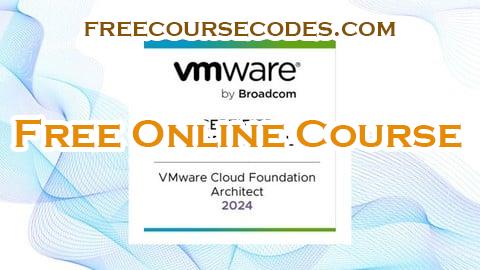
- Promoted by: Anonymous
- Platform: Udemy
- Category: IT Certifications
- Language: English
- Instructor: Yassine Chffori
- Duration:
- Student(s): 62
- Rate 0 Of 5 From 0 Votes
- Expires on: 2025/09/10
-
Price:
49.990
VMware Certified Professional - VMware Cloud Foundation Architect 2025 (2V0-13.25) PRACTICE EXAM
Unlock your potential with a Free coupon code
for the "VCP VMware Cloud Foundation Architect 2025 (2V0-13.25) EXAM" course by Yassine Chffori on Udemy.
This course, boasting a 0.0-star rating from 0 reviews
and with 62 enrolled students, provides comprehensive training in IT Certifications.
Spanning approximately
, this course is delivered in English
and we updated the information on September 06, 2025.
To get your free access, find the coupon code at the end of this article. Happy learning!
This course trains architects and senior engineers to design, validate and operate enterprise-grade VMware Cloud Foundation (VCF) solutions. Students learn to translate business requirements into documented VCF logical and physical designs, make trade-offs using AMPRS (Availability, Manageability, Performance, Recoverability, Security), build automation and lifecycle strategies, and validate designs with monitoring, BCDR and performance practices. The course is both conceptual and hands-on — every design topic includes practical lab exercises and real-world decision scenarios.
Who should attend
Cloud architects, SDDC architects, senior systems engineers
Platform/SRE leaders designing VCF-based private clouds or service provider fleets
Candidates preparing for the VMware VCP-VCF Architect exam (2V0-13.25)
Technical leads responsible for migration, automation, and lifecycle planning
Prerequisites
Must-have:
Hands-on VMware vSphere experience (vCenter, ESXi, VM lifecycle, HA basics)
Data center fundamentals (networking, storage, compute)
Comfortable with Linux shell and basic scripting
Recommended:
Familiarity with vSAN, NSX fundamentals, SDDC Manager, Kubernetes basics, IaC (Terraform/Ansible), and monitoring concepts
Course learning outcomes (what learners will be able to do)
After completing this course learners will be able to:
Design VCF architectures — map business & technical requirements into logical and physical designs.
Apply AMPRS trade-offs to satisfy SLAs and operational constraints.
Build lifecycle and automation strategies using VCF Operations (blueprints, BOMs, fleet workflows).
Create and validate BCDR/DR plans for management and workload domains.
Specify security controls (identity, secrets, NSX micro-segmentation, encryption, audit).
Plan workload migration and onboarding with rollback and validation tests.
Design monitoring, capacity planning, and cost analytics for mixed VM/Kubernetes workloads.
Size, benchmark and tune VCF stacks for performance and scalability.
Course modules (titles, objectives, topics, hands-on labs & assessments)
Module 1 — VCF Architecture Design — Mapping Requirements to Logical & Physical Designs
Objective: Translate business goals and constraints into VCF architecture choices.
Topics: Requirements gathering, conceptual vs logical vs physical models, mapping requirements → design decisions, AMPRS framing.
Lab: Create a conceptual model and translate to a VCF logical design for a multi-AZ deployment.
Assessment: Design review & critique exercise.
Module 2 — AMPRS Tradeoffs — Designing for Availability, Manageability, Performance, Recoverability & Security
Objective: Make defensible trade-offs and document impacts.
Topics: Availability zones, stretched clusters, HA/FT, lifecycle impacts, security implications, RTO/RPO mapping.
Lab: Select design options for a given SLA matrix; produce AMPRS impact table.
Assessment: Case scenario (multi-objective optimization).
Module 3 — Lifecycle Management & Automation with VCF Operations
Objective: Automate BOMs, upgrades, and fleet lifecycle across VCF instances.
Topics: BOMs/instance management, upgrade waves, configuration drift, fleet orchestration, blueprints & IaC.
Lab: Create a blueprint, run a test deployment, and schedule a BOM upgrade wave.
Assessment: Performance-based task: deploy and upgrade while demonstrating rollback.
Module 4 — BCDR & Disaster Recovery Planning for Management and Workload Domains
Objective: Design and validate DR plans for management and workload domains.
Topics: Protection profiles (management vs workload), NSX/overlay considerations, orchestration & test plans, SRM/Live Site Recovery, instance recovery.
Lab: Orchestrate non-disruptive DR test and produce a runbook.
Assessment: Case study: craft RTO/RPO and recovery runbook for a given business case.
Module 5 — Security Design for VCF — Identity, Secrets, Micro-segmentation & Encryption
Objective: Harden VCF management and workload planes.
Topics: Identity/SSO boundaries, secrets/cert lifecycle, NSX DFW micro-segmentation, vSAN/vMotion encryption, logging/SIEM design.
Lab: Implement micro-segmentation rules for a multi-tier app and configure certificate rotation.
Assessment: Written justification of design decisions (security implications).
Module 6 — Workload Migration & Onboarding Strategies (HCX, P2V, Storage Planning)
Objective: Migrate and onboard workloads with minimal disruption.
Topics: Five-R classification, HCX L2/L3 extension, P2V workflows, storage mapping / integration w/ vSAN, rollback patterns.
Lab: Execute an HCX migration with L2 extension and validate app behavior.
Assessment: Migration plan and execution checklist submission.
Module 7 — Monitoring, Capacity Planning & Cost Analytics for Mixed Workloads
Objective: Build an operational observability and capacity strategy.
Topics: VCF Operations observability (metrics/logs/traces), Prometheus/Telegraf, service mesh telemetry, predictive capacity and showback.
Lab: Configure workload infra telemetry, create dashboards, run capacity “what-if”.
Assessment: Provide capacity forecast and remediation plan.
Module 8 — Performance & Scalability Design — Sizing, Benchmarking & Tuning
Objective: Size and validate high-performance VCF designs (GPU, NVMe, network fabric).
Topics: Monster VMs, vSAN ESA, leaf-spine fabrics, NUMA/host tuning, benchmarking (VMmark, custom).
Lab: Run a synthetic workload, capture bottlenecks, and apply tuning.
Assessment: Performance tuning report with before/after metrics.
Module 9 — Consumption & Tenant Design, Self-Service, Governance & Multi-Region Operations
Objective: Architect tenant models, quotas, policy-as-code and federation.
Topics: Organizations/Projects/Namespaces, catalogs/content hub, policy enforcement, chargeback/showback, region/zone mapping, federation.
Lab: Build a tenant with quotas, publish catalog, enforce validating admission policies.
Assessment: Tenant design & governance checklist.
Module 10 — Capstone: End-to-End Design, Validation & Exam Preparation
Objective: Synthesize learning; present an end-to-end VCF solution.
Topics: Design package contents (diagrams, BOM, runbooks, test plans), exam tips and sample PBCQs.
